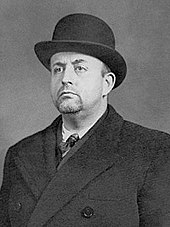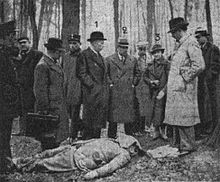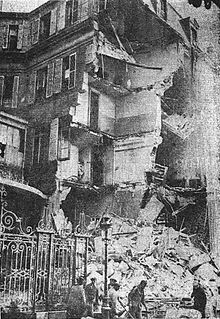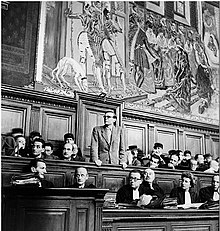La Cagoule
| La Cagoule (The Cowl) | |
|---|---|
| Leader | Mouvement Social Révolutionnaire Service d'ordre légionnaire |
La Cagoule (The
It opposed the left-wing Popular Front (in office, June 1936 to 1938). La Cagoule was founded by Eugène Deloncle. Among others, the founder of the cosmetics company L'Oréal, Eugène Schueller, bankrolled the clandestine movement.
The group performed assassinations, bombings, sabotage of armaments, and other violent activities, some intended to cast suspicion on communists through
Names
It was originally the Secret Organisation for Revolutionary National Action (Osarn or OSAR, Organisation secrète d'action révolutionnaire nationale). Later it was officially the Secret Committee of Revolutionary Action (CSAR, Comité secret d'action révolutionnaire).
Third Republic

The group was founded in 1936 or 1937 by Eugène Deloncle and enjoyed privileged relations within industrial circles (National Federation of Ratepayers, Lesieur, L'Oréal etc).[3]
An important member was
Another member was Jean Filiol, who was appointed as the head of the Milice in Limoges. He fled to Spain at the end of World War II and he worked in the Spanish subsidiary of L'Oréal. Gabriel Jeantet was a lover of a sister of François Mitterrand, who later recommended him for the Order of the Francisque.[4] Dr. Henri Martin was a physician suspected of having forged the Pacte synarchique and worked for the Organisation armée secrète (OAS) after World War II.[5]
Mohammed El Maadi, the head of La Cagoule for French Algeria, started the antisemitic newspaper Er Rachid and organised the North-African Brigade, known as SS-Mohammed, in 1944.
The group drew most of its members from
In Nice, new members were initiated in a formal ritual. In the presence of the Grand Master, dressed in red and accompanied by his assesseurs dressed in black, with their faces covered, new members stood before a table draped with a French flag. A sword and torches were placed on it. Each man raised his right arm and swore the oath, Ad majorem Galliæ gloriam ("For the greater glory of France").
The paramilitary organisation was active in the provinces. In Paris, it organised militias and demonstrations and amassed arms. It attempted to assassinate French Prime Minister Léon Blum, trained men in terrorism, built underground prisons and "ran guns in Belgium, Switzerland and Italy".[4]

La Cagoule directed its members in various actions aimed at creating suspicions of communists to destabilise and to destroy the French Republic. Some argue that in the

Organised along military lines, the Cagoule infiltrated parts of the
It was infiltrated by the French police. On 15 November 1937, Marx Dormoy, Minister of the Interior and the highest officer of law enforcement, denounced its plot and ordered wide arrests of members. The French police seized 2 tons of high explosives, several anti-tank or anti-aircraft guns, 500 machine guns, 65 submachine guns, 134 rifles and 17 sawn-off shotguns.[11] Some of the arms were of German or Italian origin, and about 70 men were arrested. Deloncle had boasted that he had 12,000 men under his order in Paris, and 120,000 in the provinces, but it is likely there were no more than 200 men who knew much about the organization and its structure, and another several hundred who were more loosely affiliated with the group.[4]

Reactions to the plot and the revelations by the French government about the Cagoule varied among the international media. In the United States, the editors of the
The journalists of
At the outbreak of World War II, the French government released imprisoned Cagoulards to fight in the French Army. Some entered the Milice, such as Jacques de Bernonville.
During the
Organization
- Premier Bureau: Eugène Deloncle and Jacques Corrèze
- Deuxième Bureau (intelligence): Dr. Henri Martin, Alfred Corre (Dagore)
- Troisième Bureau (operations): Georges Cachier
- Quatrième Bureau (recruits and equipment): Jean Moreau de La Meuse
- Sources of funding: Eugène Schueller (L'Oreal), Louis Renault, Lemaigre Dubreuil (owner of table oil Lesieur and department stores Le Printemps), Gabriel Jeantet (Lafarge cements), Pierre Pucheu (Comptoir Sidérurgique)
The Cagoule was organised into cells. Light cells had eight men, armed with
The "street fighting" handbook was titled Secret Rules of the Communist Party to avoid revealing the Cagoule in case the booklet was found by the police.[13]
World War II
During
Other cagoulards sided against the Germans, either as members of the Resistance (such as
Postwar

The cagoulards arrested for the 1937 conspiracy were not brought to trial for those charges until 1948, after the liberation of France. By then, many had served in the Vichy government or the Resistance, and few of them were brought to trial.[4]
See also
- Organisation Armée Secret (OAS)
- Propaganda Due - masonic secret organization infiltrated in the Italian government
- La Main Rouge - Terrorist organization operated by a French intelligence agency
- Anti-communist mass killings
- Organized crime
- Strategy of tension
- Secret society
Notes
- ^ Press nickname coined by the Action Française nationalist Maurice Pujo
References
- ^ Cullen, S. (2018) World War II Vichy French Security Troops, Osprey Pub.
- ^ Geoffrey Warner, "The Cagoulard Conspiracy" History Today (July 1960) 10#0 pp. 443–450.
- ISBN 2020232006
- ^ a b c d e f Finley-Croswhite, Annette; Brunelle, Gayle K. (Winter 2006). "Murder in the Metro". Quest. 9 (1). Old Dominion University. Archived from the original on 30 May 2014.
- ^ Péan, Pierre (1993) Le Mystérieux docteur Martin, 1895–1969. Fayard
- ^ Kauffer, Rémi (1 July 2007). "La Cagoule tombe le masque". Historia. 108. Archived from the original on 3 October 2008.
- ^ "Foreign News: Stalin, Navachine & Blum", Time, 8 February 1937, accessed 24 July 2012
- S2CID 154546885.
- JSTOR 20028925.
- ^ "Monstrous Conspiracy", Time Magazine, 6 December 1937
- ^ "Terrible Gravity", Time Magazine, 29 November 1937
- ^ "Death by bomb", Time, 4 August 1941
- ^ Spivak, John L. (1939). "Ch. III. Secret Armies, the new tactics of Nazi warfare". France's Secret Fascist Army. New York: Modern Age Books. p. 31. Archived from the original on 27 June 2009. Retrieved 28 May 2008.
- ^ de Kérillis, Henri (1946) I Accuse De Gaulle Harcourt, Brace & Co.
